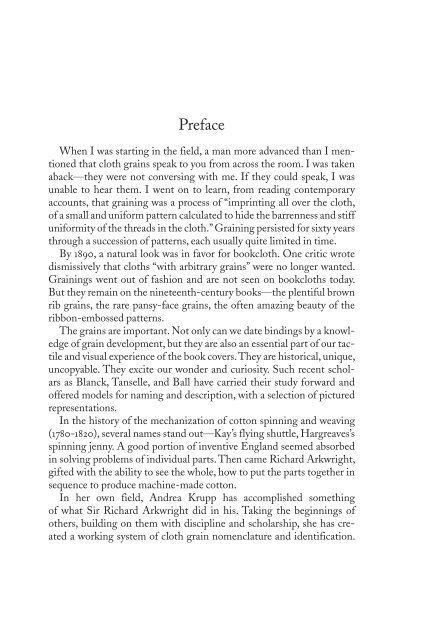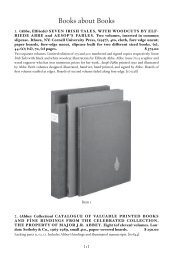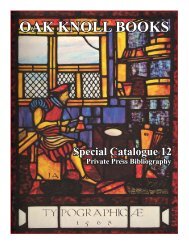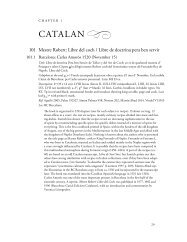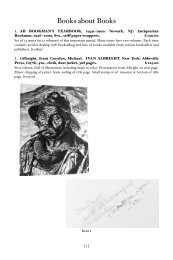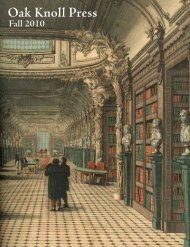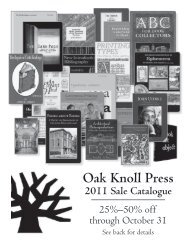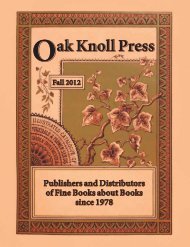View Excerpt (PDF) - Oak Knoll Books
View Excerpt (PDF) - Oak Knoll Books
View Excerpt (PDF) - Oak Knoll Books
Create successful ePaper yourself
Turn your PDF publications into a flip-book with our unique Google optimized e-Paper software.
Bookcloth in England and America, 1823–50<br />
vii<br />
Preface<br />
When I was starting in the field, a man more advanced than I mentioned<br />
that cloth grains speak to you from across the room. I was taken<br />
aback—they were not conversing with me. If they could speak, I was<br />
unable to hear them. I went on to learn, from reading contemporary<br />
accounts, that graining was a process of “imprinting all over the cloth,<br />
of a small and uniform pattern calculated to hide the barrenness and stiff<br />
uniformity of the threads in the cloth.” Graining persisted for sixty years<br />
through a succession of patterns, each usually quite limited in time.<br />
By 1890, a natural look was in favor for bookcloth. One critic wrote<br />
dismissively that cloths “with arbitrary grains” were no longer wanted.<br />
Grainings went out of fashion and are not seen on bookcloths today.<br />
But they remain on the nineteenth-century books—the plentiful brown<br />
rib grains, the rare pansy-face grains, the often amazing beauty of the<br />
ribbon-embossed patterns.<br />
The grains are important. Not only can we date bindings by a knowledge<br />
of grain development, but they are also an essential part of our tactile<br />
and visual experience of the book covers. They are historical, unique,<br />
uncopyable. They excite our wonder and curiosity. Such recent scholars<br />
as Blanck, Tanselle, and Ball have carried their study forward and<br />
offered models for naming and description, with a selection of pictured<br />
representations.<br />
In the history of the mechanization of cotton spinning and weaving<br />
(1780-1820), several names stand out—Kay’s flying shuttle, Hargreaves’s<br />
spinning jenny. A good portion of inventive England seemed absorbed<br />
in solving problems of individual parts. Then came Richard Arkwright,<br />
gifted with the ability to see the whole, how to put the parts together in<br />
sequence to produce machine-made cotton.<br />
In her own field, Andrea Krupp has accomplished something<br />
of what Sir Richard Arkwright did in his. Taking the beginnings of<br />
others, building on them with discipline and scholarship, she has created<br />
a working system of cloth grain nomenclature and identification.
viii<br />
Andrea Krupp<br />
Advances in photographic reproduction allow the showing of a picture<br />
of every grain, referenced by name and number. To me the most valuable<br />
feature is the precise date span assigned to each grain—provisionally,<br />
since this is a system destined to expand.<br />
Now, in truth, cloth grains speak a language—a language we can all<br />
learn to read. Andrea’s book provides its dictionary and grammar—concise,<br />
handy, indispensable. It would be impossible to embark on any consideration<br />
of cloth grains without it.<br />
Sue Allen
Bookcloth in England and America, 1823–50<br />
ix<br />
Acknowledgements<br />
I would like to acknowledge the support and assistance of my friends<br />
and colleagues at the Library Company. From the very beginning of<br />
this project, Chief of Conservation Jennifer W. Rosner has been a close<br />
collaborator. Her organized mind shaped the Database of 19th-Century<br />
Cloth Bindings, from which my data for this research and the Catalogue<br />
of 19th-Century Bookcloth Grains was drawn. Her dogged persistence<br />
over a span of twelve years gave the momentum to this very large, ambitious<br />
project, and thanks to her efforts, the Database is finally in the last<br />
stages of preparation for mounting online. Curator of Printed <strong>Books</strong><br />
Wendy Woloson provided invaluable help with her skillful editing. Also,<br />
with her sharp eyes and curator’s purse she enthusiastically helped to<br />
build the Library Company’s collection of 19th-century cloth bindings.<br />
Early on, Librarian Jim Green recognized the potential utility of my<br />
research and offered unwavering support along the way, and I credit<br />
Director John Van Horne for fostering a work environment that values<br />
staff involvement with the collections. Sharon Hildebrand and Linda<br />
Wisniewski provided expertise in scanning the grain patterns, and<br />
Jenny Ambrose continues to be a key resource for navigating the technological<br />
intricacies of mounting the Database of 19th-Century Cloth<br />
Bindings, and soon, the Catalogue of 19th-Century Bookcloth Grains<br />
online. Thank you to all of my colleagues in the McLean Conservation<br />
Department: Alice Austin and Kristin Balmer, as well as the rest of the<br />
staff of the Library Company in the Cataloging Department, the Print<br />
and Photograph Department, the reading room, and administration.<br />
Special thanks to Michael Zinman, head cheerleader of this project<br />
from its inception. He has been an important contributor intellectually,<br />
materially, and financially.<br />
The compilation of grain patterns in the CBG was a group effort, and<br />
I thank all the contributors whose sharp eyes and minds have enriched<br />
my work. Todd Pattison, Willman Spawn, Sue Allen, Steve Beare,<br />
Tom Kinsella, and Robert Milevski provided not only contributions of
Andrea Krupp<br />
patterns but also intellectual exchange. Todd Pattison contributed four<br />
new patterns: Dia14, Ft44, As14 and Gs3. Stuart Walker of the Boston<br />
Public Library made a significant contribution of fourteen new patterns.<br />
As13, Fs18, Fs19, Fs20, Ft41, Ft42, Ft43, Ft47, Gs1, Gs2, Gt20, Gt21, Gt22<br />
and Gt23 appear courtesy of the Boston Public Library, and I thank<br />
them for providing scans of these patterns. Ft29 appears courtesy of the<br />
Athenaeum of Philadelphia. At17 and As15 appear courtesy of Steve<br />
Beare. I gleaned two patterns from the Publishers’ Bindings Online<br />
website: Ft45 and Ft46; these images appear courtesy of the W.S. Hoole<br />
Special Collections Library at the University of Alabama.
Bookcloth in England and America, 1823–50<br />
<br />
Bookcloth in England and America, 1823–50<br />
Part 1: Early Bookcloth<br />
In 1823, a London bookbinder named Archibald Leighton collaborated<br />
with a dyer to transform plain cotton fabric into a material suited<br />
to the covering of books. Bookcloth, as it came to be known, was easy<br />
to work with, easy to decorate, and much cheaper than leather. The new<br />
binding material soon revolutionized bookbinding — both the process<br />
and the product — in England and America. Book historians such as<br />
Michael Sadleir, John Carter, Joseph Rogers, Douglas Ball, and most<br />
recently William Tomlinson and Richard Masters have told this story<br />
of invention. However, the history of the early period of bookcloth,<br />
from the ‰rst experiments up to the time when manufacturers perfected<br />
the product and launched an industry, from 1823 to about 1850, remains<br />
frustratingly obscure.<br />
Little is known about how, where, and by whom early bookcloth was<br />
produced. Primary source material that would provide documentary<br />
evidence about the manufacture and use of bookcloth during the ‰rst<br />
decades of its existence, such as advertisements, patents, and publishers’<br />
and binders’ records, remains scarce. However, cloth-bound books<br />
Douglas Leighton, “Canvas and Bookcloth: An Essay on Beginnings,” The<br />
Library, 5th ser., 3 ( June 1948): 39-49.<br />
Michael Sadleir, The Evolution of Publishers’ Binding Styles, 1770–1900 (London:<br />
Constable; New York: R. R. Smith, 1930); John Carter, Binding Variants (London:<br />
Constable and Company, 1932); Joseph W. Rogers, “The Rise of American Edition<br />
Binding” in Bookbinding in America, ed. H. Lehmann-Haupt (New York: R. R.<br />
Bowker, 1941); Douglas Ball, Victorian Publishers’ Bindings (Williamsburg, VA:<br />
Bookpress, 1985); William Tomlinson and Richard Masters, Bookcloth, 1823–1980<br />
(Mellor, Stockport, Cheshire: Dorothy Tomlinson, 1996)<br />
Some of the earliest U.S. patents exist only as subject entries in an index, the
Andrea Krupp<br />
themselves are a rich source of empirical information, and repositories<br />
such as the Library Company of Philadelphia hold them in plentiful<br />
supply. Since 1995, the Library Company’s Chief of Conservation,<br />
Jennifer Woods Rosner, and I have been compiling data about the structure<br />
and appearance of cloth-covered bindings in our collection. The<br />
Database of Nineteenth-century Cloth Bindings currently contains<br />
data on approximately 3,000 books published between 1824 and 1900.<br />
Each entry comprises over sixty ‰elds of information that record the<br />
details of the book’s structure and appearance. This article focuses on<br />
two of those recorded elements: the date of publication as given on the<br />
title-page and the grain of the cloth. While compiling the database we<br />
identi‰ed 160 new bookcloth grain patterns. The majority of them,<br />
135, ‰rst appear on American books published before 1850. By way of<br />
comparison, current resources illustrate ‰fty-seven diˆerent bookcloth<br />
grains, and only seventeen of them are pre-1850 patterns.<br />
The study of nineteenth-century bookbindings is advancing with<br />
increased attention to the materiality of the book and the information<br />
that can be gleaned from it, because documentary evidence is so rare.<br />
Accordingly, the study of bookcloth grain patterns by necessity must<br />
progress towards increasingly detailed and speci‰c identi‰cation and away<br />
from generalized divisions of grain patterns by family. The large number<br />
of bookcloth grains that has been amassed underscores the need for a<br />
detailed and accurate “‰eld guide” that records individual cloth grain patactual<br />
patents having burned in the great Patent O‹ce ‰re of 15 December 1836.<br />
Three of these were especially promising: a ribbon smoothing and glossing machine,<br />
1817; cloth dressing and ornamenting, 1821; manufacture of ‰gured fabrics, 1834.<br />
Both totals include 104 “ribbon-embossed” patterns. These decorative bookcloth<br />
grain patterns in Šoral, geometric, and abstract designs are discussed later in<br />
this article. Their dates of use range from the early to mid-1830s through the 1840s.<br />
Photographs of cloth grains appear in the following books: Sadleir, The<br />
Evolution of Publishers’ Binding Styles; Carter, Binding Variants; Rogers, “The Rise<br />
of American Edition Binding”; Sadleir, XIX Century Fiction: A Bibliographical<br />
Record Based on His Own Collection, 2 vols. (London: Constable; Berkeley, CA:<br />
California Univ. Press, 1951; reprinted, 1969); Jacob Blanck and Michael Winship,<br />
Bibliography of American Literature, 9 vols. (New Haven, CT: Yale Univ. Press, 1955–<br />
91); G. Thomas Tanselle, “The Bibliographical Description of Patterns,” Studies in<br />
Bibliography 23 (1970): 71–102; Philip Gaskell, A New Introduction to Bibliography<br />
(Oxford: Clarendon, 1972); Ball, Victorian Publishers’ Bindings.
Bookcloth in England and America, 1823–50<br />
<br />
terns. For example, current resources illustrate two rib grains, but we have<br />
identi‰ed ten diˆerent rib grains, each with a quanti‰able distinguishing<br />
characteristic. Furthermore, each one is associated with a limited range of<br />
dates, and eight of these rib-grain patterns ‰rst appear before 1850. Acute<br />
diagonal rib (rib9) is an example of a highly individual, easily recognizable,<br />
and potentially signi‰cant early rib-grain pattern. I have recorded<br />
nine examples of acute diagonal rib at the Library Company, and all date<br />
from 1832 to 1837. Though rare, examples of this unique grain will seem to<br />
pop oˆ the shelf once your eyes have learned to spot it.<br />
In all, 247 grain patterns have been assembled to create a new “‰eld<br />
guide” for identifying and dating nineteenth-century bookcloth. The<br />
Catalogue of Nineteenth-century Bookcloth Grains (CBG) appears in<br />
its entirety at the end of this article. The existing “descriptive” nomenclature<br />
of cloth grains provided a model for naming new patterns that<br />
was followed whenever possible. It is important to remember that the<br />
data presented in the CBG is drawn primarily from the Database of<br />
Nineteenth-century Cloth Bindings. Approximately one-quarter of the<br />
cloth bindings in the Library Company of Philadelphia’s collection of<br />
predominantly pre-1860 American imprints has been entered into the<br />
database to date. Seventy-one percent of the new grain patterns appear<br />
on American books printed before 1850, which may be partly due to the<br />
strong representation in our collection, and accordingly, the database, of<br />
pre-1860 imprints. But I believe that the diversity of cloth-grain patterns<br />
extant before 1850 is in itself an important and previously unrecognized<br />
aspect of the early history of bookcloth manufacture. Beyond amassing<br />
cloth grain varieties, the CBG records the dates of use for each grain<br />
as recorded in the Database of Nineteenth-century Cloth Bindings. <br />
Larger pools of data for both English and American imprints must be<br />
This total includes 25 new patterns added to the CBG since the first printing<br />
of this article.<br />
Part 2 of this article addresses the issues of nomenclature and descriptive vs.<br />
code-based systems of identi‰cation.<br />
Bearing in mind the publishers’ practice of binding up parts of an edition sometimes<br />
many years after its initial publication, the dating of a particular bookcloth<br />
grain based solely upon the year of imprint can be unreliable. However, after examining<br />
thousands of examples of nineteenth-century cloth-bound books, one develops<br />
an eye for the “solitary exception,” as Carter put it, and the discipline to regard<br />
it with suspicion.


